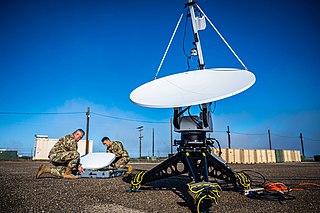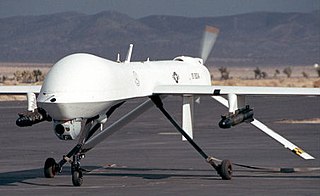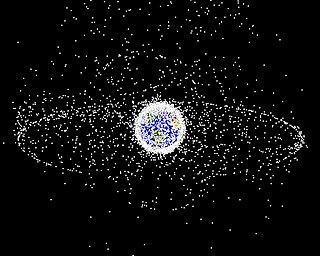Related Research Articles

The Defense Advanced Research Projects Agency (DARPA) is a research and development agency of the United States Department of Defense responsible for the development of emerging technologies for use by the military.

Surveillance aircraft are aircraft used for surveillance. They are primarily operated by military forces and government agencies in roles including intelligence gathering, maritime patrol, battlefield and airspace surveillance, observation, and law enforcement.

Electromagnetic warfare or electronic warfare (EW) is warfare involving the use of the electromagnetic spectrum or directed energy to control the spectrum, attack an enemy, or impede enemy operations. The purpose of electromagnetic warfare is to deny the opponent the advantage of—and ensure friendly unimpeded access to—the EM spectrum. Electromagnetic warfare can be applied from air, sea, land, or space by crewed and uncrewed systems, and can target communication, radar, or other military and civilian assets.

Surveillance is the monitoring of behavior, many activities, or information for the purpose of information gathering, influencing, managing or directing. This can include observation from a distance by means of electronic equipment, such as closed-circuit television (CCTV), or interception of electronically transmitted information like Internet traffic. It can also include simple technical methods, such as human intelligence gathering and postal interception.
Computer and network surveillance is the monitoring of computer activity and data stored locally on a computer or data being transferred over computer networks such as the Internet. This monitoring is often carried out covertly and may be completed by governments, corporations, criminal organizations, or individuals. It may or may not be legal and may or may not require authorization from a court or other independent government agencies. Computer and network surveillance programs are widespread today and almost all Internet traffic can be monitored.

The Information Awareness Office (IAO) was established by the United States Defense Advanced Research Projects Agency (DARPA) in January 2002 to bring together several DARPA projects focused on applying surveillance and information technology to track and monitor terrorists and other asymmetric threats to U.S. national security by achieving "Total Information Awareness" (TIA).

Total Information Awareness (TIA) was a mass detection program by the United States Information Awareness Office. It operated under this title from February to May 2003 before being renamed Terrorism Information Awareness.

The Traffic and Environmental Zone, commonly known as the "ring of steel", is the security and surveillance cordon consisting of road barriers, checkpoints and several hundred CCTV cameras surrounding the City of London, the financial district at the heart of Greater London. The measures have been used since the 1990s to deter terrorism and other threats.
LifeLog was a project of the Information Processing Techniques Office of the Defense Advanced Research Projects Agency (DARPA) of the U.S. Department of Defense (DOD). According to its bid solicitation pamphlet in 2003, it was to be "an ontology-based (sub)system that captures, stores, and makes accessible the flow of one person's experience in and interactions with the world in order to support a broad spectrum of associates/assistants and other system capabilities". The objective of the LifeLog concept was "to be able to trace the 'threads' of an individual's life in terms of events, states, and relationships", and it has the ability to "take in all of a subject's experience, from phone numbers dialed and e-mail messages viewed to every breath taken, step made and place gone".

Military robots are autonomous robots or remote-controlled mobile robots designed for military applications, from transport to search & rescue and attack.
Mass surveillance is the intricate surveillance of an entire or a substantial fraction of a population in order to monitor that group of citizens. The surveillance is often carried out by local and federal governments or governmental organizations, but it may also be carried out by corporations. Depending on each nation's laws and judicial systems, the legality of and the permission required to engage in mass surveillance varies. It is the single most indicative distinguishing trait of totalitarian regimes. It is often distinguished from targeted surveillance.

An unmanned combat aerial vehicle (UCAV), also known as a combat drone, fighter drone or battlefield UAV, is an unmanned aerial vehicle (UAV) that is used for intelligence, surveillance, target acquisition, and reconnaissance and carries aircraft ordnance such as missiles, anti-tank guided missiles (ATGMs), and/or bombs in hardpoints for drone strikes. These drones are usually under real-time human control, with varying levels of autonomy. UCAVs are used for reconnaissance, attacking targets and returning to base; unlike kamikaze drones which are only made to explode on impact, or surveillance drones which are only for gathering intelligence.

Future Combat Systems (FCS) was the United States Army's principal modernization program from 2003 to early 2009. Formally launched in 2003, FCS was envisioned to create new brigades equipped with new manned and unmanned vehicles linked by an unprecedented fast and flexible battlefield network. The U.S. Army claimed it was their "most ambitious and far-reaching modernization" program since World War II. Between 1995 and 2009, $32 billion was expended on programs such as this, "with little to show for it".

The history of unmanned combat aerial vehicles (UCAVs) is closely tied to the general history of unmanned aerial vehicles (UAVs). While the technology dates back at least as far as the 1940s, common usage in live operations came in the 2000s. UCAVs have now become an important part of modern warfare, including in the Syrian civil war, the 2020 Nagorno-Karabakh war and during the 2022 Russian invasion of Ukraine.

The Video and Image Retrieval and Analysis Tool (VIRAT) program is a video surveillance project funded by the Information Processing Technology Office of the Defense Advanced Research Projects Agency (DARPA).

The Heterogeneous Aerial Reconnaissance Team (HART)—formerly known as the "Heterogeneous Urban RSTA Team (HURT)"—program was an aerial surveillance project funded by the Information Processing Technology Office of the Defense Advanced Research Projects Agency with program managers John Bay and Michael Pagels. The purpose of the program was to develop systems that could provide continuous, real-time, three-dimensional surveillance of large urbanized areas, using unmanned aerial vehicles. The project team was led by Northrop Grumman Corporation, and involved several other academic and corporate researchers.

Catcher's Mitt is the name of a study conducted by the United States Defense Advanced Research Projects Agency (DARPA) to "better understand the issues and challenges involved with removing man-made debris from earth orbit." DARPA's goal was to use the study to determine both if DARPA should invest more resources in orbital debris removal and, if so, how to best do so.

The Boeing Phantom Ray is an American demonstration stealth unmanned combat air vehicle (UCAV) developed by Boeing using company funds. The autonomous Phantom Ray is a flying wing around the size of a conventional fighter jet, and first flew in April 2011. It will conduct a program of test flights involving surveillance, ground attack and autonomous aerial refueling missions. The developers say it can carry 4,500 pounds of payload.

The Space Surveillance Telescope (SST) is a Southern Hemisphere-based U.S. Space Force telescope used for detecting, tracking, and cataloguing satellites, near-Earth objects, and space debris.

The practice of mass surveillance in the United States dates back to wartime monitoring and censorship of international communications from, to, or which passed through the United States. After the First and Second World Wars, mass surveillance continued throughout the Cold War period, via programs such as the Black Chamber and Project SHAMROCK. The formation and growth of federal law-enforcement and intelligence agencies such as the FBI, CIA, and NSA institutionalized surveillance used to also silence political dissent, as evidenced by COINTELPRO projects which targeted various organizations and individuals. During the Civil Rights Movement era, many individuals put under surveillance orders were first labelled as integrationists, then deemed subversive, and sometimes suspected to be supportive of the communist model of the United States' rival at the time, the Soviet Union. Other targeted individuals and groups included Native American activists, African American and Chicano liberation movement activists, and anti-war protesters.
References
- ↑ Wikisource:DARPA Solicitation Number SN03-13: Pre-Solicitation Notice: COMBAT ZONES THAT SEE (CTS)
- 1 2 3 Schachtman, Noah (July 8, 2003). "Big Brother Gets a Brain". The Village Voice. Retrieved 2009-10-11.
- ↑ Tether, Tony (March 9, 2005). "Statement by Dr. Tony Tether (DARPA) to the Senate Armed Services committee" (PDF). Archived from the original (PDF) on September 1, 2009. Retrieved 2009-10-11.
- ↑ "Another Tool For Big Brother?". Wired. July 2, 2003. Retrieved 2009-10-11.
- ↑ Sniffen, Michael (August 1, 2003). "Spy Project Driving Fear Of Surveillance". GlobalSecurity.org. Retrieved 2009-10-11.